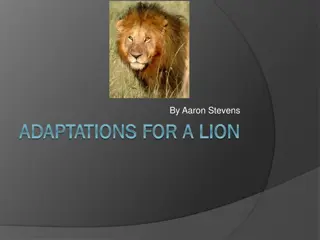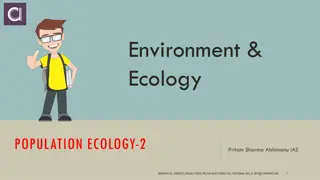Interactions Among Living Things and Adaptations in Nature
Understanding the interactions among living things, such as competition, predation, and symbiosis, sheds light on how organisms adapt to their environments through natural selection. Each organism occupies a unique niche, defining its role in the ecosystem. Predation plays a crucial role in population dynamics, affecting both predator and prey populations. Adaptations in predators and prey contribute to their survival in the constant struggle for existence in nature.
Download Presentation

Please find below an Image/Link to download the presentation.
The content on the website is provided AS IS for your information and personal use only. It may not be sold, licensed, or shared on other websites without obtaining consent from the author.If you encounter any issues during the download, it is possible that the publisher has removed the file from their server.
You are allowed to download the files provided on this website for personal or commercial use, subject to the condition that they are used lawfully. All files are the property of their respective owners.
The content on the website is provided AS IS for your information and personal use only. It may not be sold, licensed, or shared on other websites without obtaining consent from the author.
E N D
Presentation Transcript
Interactions Among Living Things
Adapting to the Environment Natural Selection a characteristic that makes an individual better suited to its environment may eventually become common in that species. Natural selection results in adaptationsor behaviors and physical characteristics that allow organisms to live successfully in their environments. Niche The role of an organism in its habitat, or how it makes its living.
Niche An organism s niche includes: the organism s food how it obtains food other organisms that use the organism as food when and how it reproduces any physical characteristics required to survive
Three types of Interactions among Organisms Competition Predation Symbiosis
Competition It is the struggle between organisms as they attempt to use the same limited resource Occurs when two species occupy the same niche Why can t two species occupy the same niche? If two species occupy the same niche, they will compete directly against each other and one species will eventually die off
Predation The interaction in which one organism kills another for food is called predation The organism that does the killing is the predator The organism that is killed is the prey
Predation and Population Size If death rate > birth rate, then population size decreases If birth rate > death rate, then population size increases When the death rate exceeds the birth rate, the size of the population decreases, resulting in a decrease in the size of the population of their prey. As this occurs, the predators go without food and the predator population decreases. Predator and prey populations rise and fall in related cycles.
Adaptations Predator adaptations Help them catch and kill prey Cheetah can run very fast for a short time Jellyfish s tentacles contain a poisonous substance that paralyze tiny water animals Prey adaptations Help them avoid becoming prey Alertness and speed of an antelope help protect it from its predators Smelly spray of a skunk
Defense Strategies False Coloring Mimicry Protective Covering Warning Coloring Camouflage
Symbiosis Organisms within a community interact with each other in many ways. Some are predators, some are prey. Some compete with one another, some cooperate. Some species form symbiotic relationships with other species: Mutualism benefits both Commensalism benefits one, other unaffected Parasitism benefits one, harms other
Ecosystems are always changing Primary Succession a series of changes that occur in an area where no soil or organisms exist. In a barren area, a new community is established with pioneer species (first species in the area), like mosses, that do well with little or no soil. Mosses eventually give way to coniferous trees.
Ecosystems are always changing Secondary Succession a series of changes that occur in an area where the ecosystem has been disturbed. When a disturbance (fire, flood, or tornados) damages a community but soil remains, the community gets reestablished from seeds and roots left behind. Grasses grow, then small shrubs, and eventually trees.























